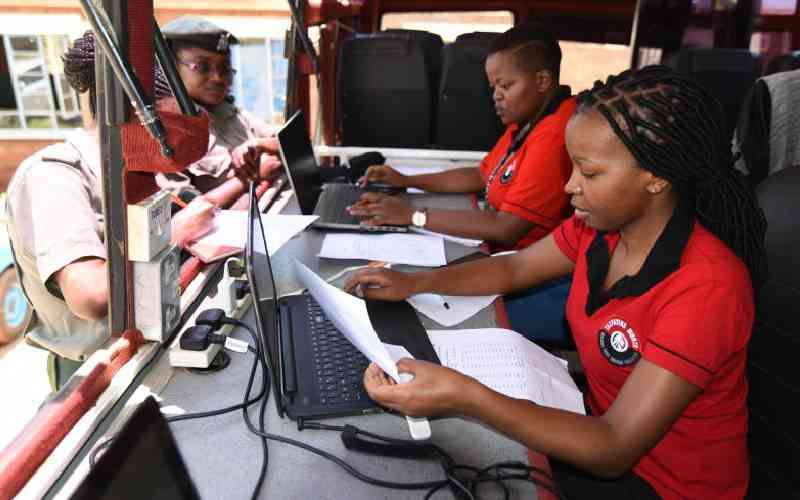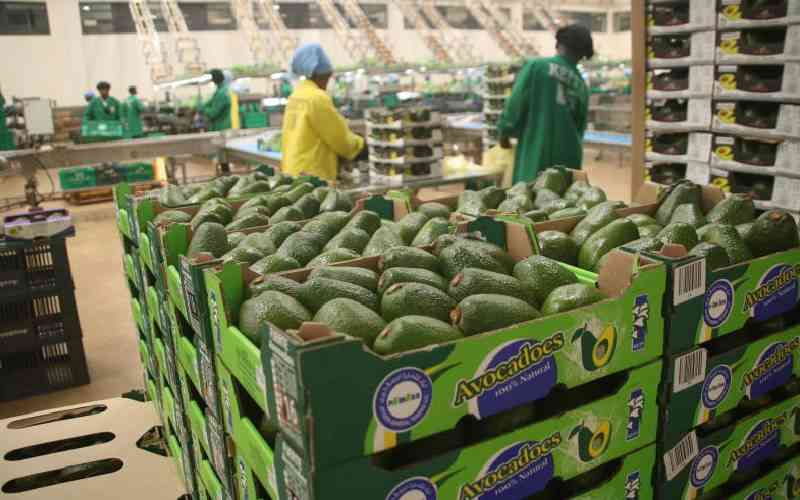
George Wanjohi and his wife Monica Njoki display some of their Kiss chocolate products at their factory in Nairobi, (PIUS CHERUIYOT/STANDARD)
For decades, the chocolate industry in Kenya has been dominated by international brands. This dominance has been so prolific that most potential entrepreneurs interested in the sector feel intimidated at the thought of going against these big firms.
But George Wanjohi and Monica Njoki, both 35, refused to be daunted by this when they decided to launch their own brand, Kiss Chocolate.
Kiss Chocolate is made and packaged in Nairobi, and comprises white and milk chocolate, both plain and with added fruit.
“My wife Monica and I have always liked chocolate. Any time we had friends travelling abroad, we would send them to bring us good chocolate,” George tells Hustle.
“In December 2015, my wife was travelling to Turkey and as usual, I told her not to forget to bring back chocolate. That’s when it occurred to us how strange it was that we often send for quality chocolate from Europe, when we have some of the world’s best cocoa in Africa.”
Risk takers
Having run a real estate company and an entertainment company before, George and Monica say they’ve always been risk takers. So when they got thinking about the general quality of chocolate in Kenya, they set out to research how viable it would be to start a chocolate factory.
“During my trip to Turkey, I bought all types of chocolate,” Monica says, “but this time it wasn’t just for consumption, it was for comparison purposes. I couldn’t wait to get home and examine the different qualities and tastes.”
In the year that followed Monica’s return, the couple spent hours researching chocolate production, flavours, packaging and distribution.
They were also keen to test the products in the market to improve on what’s considered good, affordable chocolate in Kenya.
“My wife was a laboratory technician working at the Garissa Provisional Hospital before she quit her job back in 2009. So she still had the skills needed for a lab; the eye for detail and the patience for desired results. Making chocolate is a science. Every temperature, every ingredient, every type of storage adds up to the difference between ordinary chocolate and great chocolate,” George says.
Chocolate is made from what is called a base product, which is derived from the cocoa bean.
It is this product that is then altered using heat, cooling systems and added flavours and ingredients to result in the different chocolate products we enjoy. The process of turning raw cocoa into a chocolate base is, however, quite expensive because it requires a significant amount of skill and resources.
Starting out, George and Monica did not have the capacity to manufacture their own base chocolate, so they opted to source for it from Europe. They eventually settled on a Belgian supplier.
Their first order cost Sh36,000 for 10 kilos.
“It took us about six months of experimenting on the base chocolate to get the taste we were after. We knew we were competing with known brands, so we didn’t want to mimic them,” George says. “We had to create something unique.”
The taste
He explains that the temperature chocolate is created at greatly determines its quality; this system is known as ‘tempering’. Base chocolate is heated to a specific degree and then allowed to cool down.
Cold chocolate is added to the mixture, which is how chocolate crystals are formed. It is these crystals that provide texture and subtle unique tastes.
“We were working from our kitchen using very basic home equipment. Let me tell you, it took us hours and hours to get it right, and then we started experimenting with flavours,” George says.
“We knew we wanted fruits in the chocolate to complement our tropical weather and the Kenyan palate. We settled on the berry family – strawberry, blueberry and raspberry.”
George and Monica used their friends and family members as test subjects. They would offer chocolate during functions like weddings or family gatherings, and then collect feedback.
After several months of doing this and altering their chocolates based on the response they got, they reached a final product.
In August 2016, George and Monica ordered their first set of equipment.
By March 2017, when they officially launched Kiss Chocolate, they’d spent Sh10 million on machinery and raw materials.
“The whole process was nerve-racking. I remember the first time we spent huge sums of money on ordering equipment – we both thought, this is it; we can’t turn back now. Our friends and family had liked our product, but we hadn’t approached a single outlet to stock it. And we were already millions of shillings in.”
George, who deals more with the communications aspect of the business, while his wife deals with production, now had the pressure to get orders for their product. He wrote proposals and approached leading retail stores.
“My first pitch was with the Chandarana chain. I had called earlier to find out what their requirements were and was told to come to the office on a Monday afternoon. That is when they listen to pitches for new products,” George says.
“There were about 15 other people waiting, which turned out to be a blessing for me because when the CEO came out of his office and saw the queue, he decided to listen to some of the pitches to hasten the process. I was the first one in.”
First pitch
George admits he was extremely nervous, but he went in with proper documentation, including proof of origin for his base chocolate and a Kenya Bureau of Statistics certificate. He presented seven varieties of their chocolate brand. His pitch worked.
Chandarana ordered products for 12 stores, stocking 24 pieces of each type of chocolate per store. The entire process from pitch to order took two days.
Shortly after, George acquired another order from Tuskys Supermarkets to stock 26 of their stores nationwide.
“We were exhilarated but also very frightened. This was a big order for us and it was needed in seven days. We didn’t have delivery vehicles, so we had to use our two personal cars to drive all over the country delivering chocolate,” Monica says.
“We had to drive with the air-conditioning on to ensure the chocolates didn’t melt and alter the taste!”
Kiss Chocolate has also supplied a few companies with branded products for launches, and client and employee appreciation.
Despite the fact that the company is off to a good start, George and Monica are still a long way from recouping their investment, especially taking into account the monthly overheads.
These include Sh55,000 in rent, Sh10,000 for electricity, Sh20,000 for fuel, Sh5,000 for Internet connectivity, alongside salaries and other miscellaneous costs.
Initial orders
But the two are confident that their chocolate – which retails at between Sh195 and Sh250 – will sell, based on the reception it’s received in the market so far.
In the last three months, they have restocked the stores that made initial orders, and are getting more interest from companies and wedding and event planners.
The business is also set to move from its current manufacturing base in Nairobi’s Kahawa Sukari to larger premises in Ruiru, Kiambu County.
“I think the most exciting thing is seeing reviews on our Facebook page. My favourite one was of a lady asking the supermarket where she’d bought the chocolate to restock it because it had become her newest addiction,” George says.
George and Monica are extremely proud of how far they’ve come and the fact that they have produced a chocolate made in Kenya that they believe can rival the better known brands. Their projection is that Kiss Chocolate will return a profit in its first full year.
 The Standard Group Plc is a multi-media organization with investments in media
platforms spanning newspaper print operations, television, radio broadcasting,
digital and online services. The Standard Group is recognized as a leading
multi-media house in Kenya with a key influence in matters of national and
international interest.
The Standard Group Plc is a multi-media organization with investments in media
platforms spanning newspaper print operations, television, radio broadcasting,
digital and online services. The Standard Group is recognized as a leading
multi-media house in Kenya with a key influence in matters of national and
international interest.
 The Standard Group Plc is a multi-media organization with investments in media
platforms spanning newspaper print operations, television, radio broadcasting,
digital and online services. The Standard Group is recognized as a leading
multi-media house in Kenya with a key influence in matters of national and
international interest.
The Standard Group Plc is a multi-media organization with investments in media
platforms spanning newspaper print operations, television, radio broadcasting,
digital and online services. The Standard Group is recognized as a leading
multi-media house in Kenya with a key influence in matters of national and
international interest.










